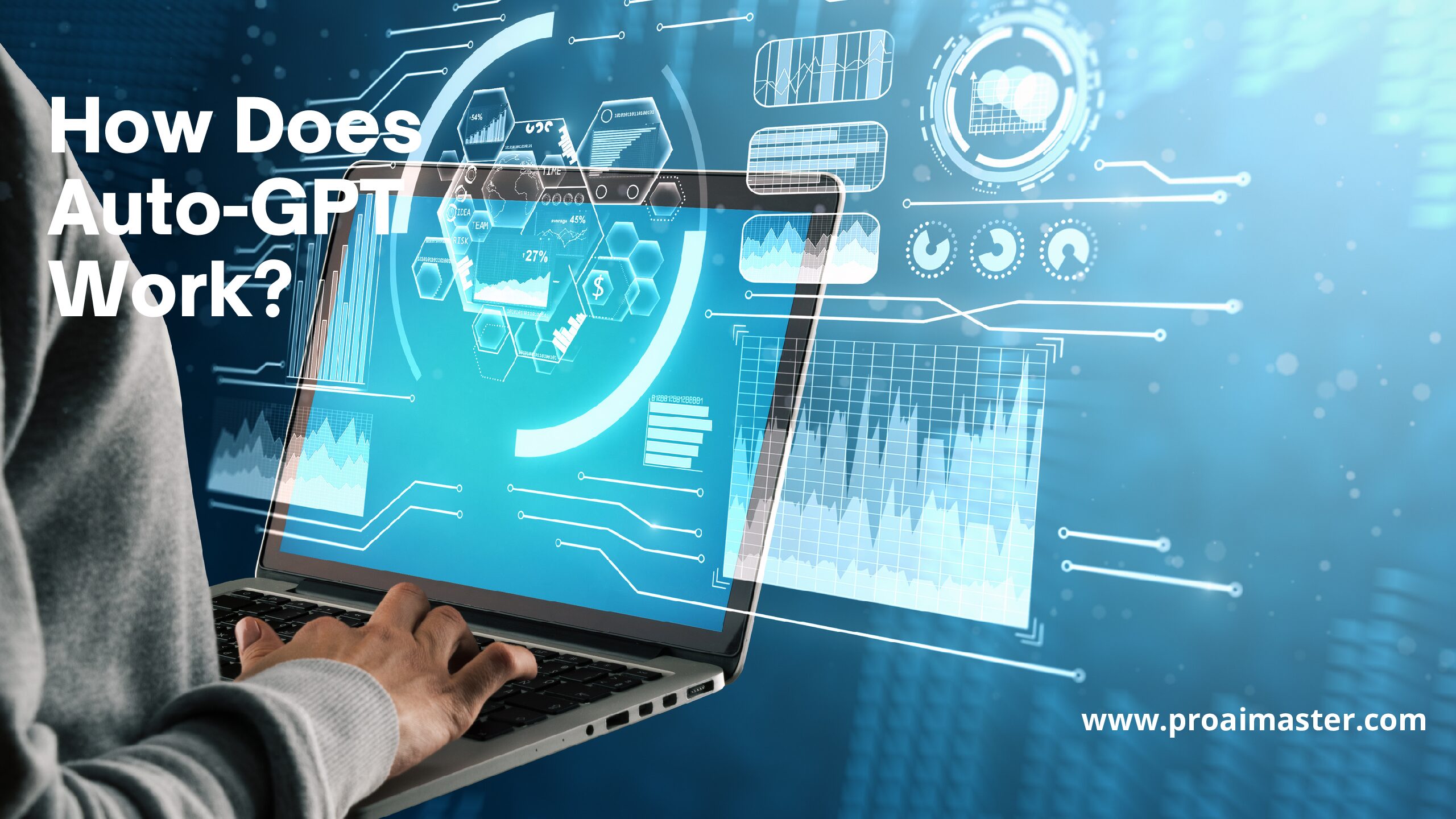How Does Auto-GPT Work? Auto-GPT has emerged as a groundbreaking development in the field of natural language processing (NLP). It harnesses the power of artificial intelligence (AI) to generate human-like text, making it a revolutionary tool for various applications.
In this article, we will delve into the workings of Auto-GPT, exploring its underlying mechanisms, training process, and practical applications.
What is Auto-GPT?

Auto-GPT stands for Automatic Generative Pre-trained Transformer. It is an advanced language model based on the GPT-3.5 architecture developed by OpenAI.
GPT, short for Generative Pre-trained Transformer, refers to a class of models designed to generate coherent and contextually relevant text based on the input provided. Auto-GPT takes this concept a step further by automating the training process.
Training Auto-GPT:
The training process of Auto-GPT involves several key steps. Initially, a large corpus of text data is collected from the internet, comprising a wide range of sources such as books, articles, websites, and more. This extensive dataset is then pre-processed to remove any irrelevant or redundant information, ensuring the model focuses on relevant patterns and language structures.
Next, the pre-processed dataset is used to train the initial version of the language model. This involves feeding the data into the model, which then learns the statistical patterns and relationships within the text. The model employs a transformer architecture, which utilizes self-attention mechanisms to capture dependencies between different words and generate coherent sequences.
Fine-tuning and AutoML:

After the initial training, Auto-GPT goes through a fine-tuning process. This involves further refining the model on specific tasks or domains by providing it with task-specific datasets. The fine-tuning helps Auto-GPT to adapt and specialize in particular contexts, making it more effective for various applications.
Auto-GPT utilizes a technique called AutoML (Automated Machine Learning) to automate the fine-tuning process. AutoML leverages algorithms and computational power to automatically search and optimize the hyperparameters of the model, resulting in improved performance and efficiency. This automation reduces the need for manual intervention and accelerates the development and deployment of models.
Language Generation and Coherence:
One of the key strengths of Auto-GPT is its ability to generate coherent and contextually relevant text. The model achieves this by leveraging its understanding of sentence structure, grammar, and semantic relationships acquired during training. Auto-GPT predicts the next word in a sequence based on the context and the previously generated words, ensuring that the generated text flows smoothly and makes sense.
However, it is important to note that Auto-GPT does not possess genuine understanding or consciousness. It operates based on patterns and statistical associations within the training data, which can sometimes lead to inaccurate or nonsensical outputs. Researchers and developers continuously work to improve the model’s performance and mitigate these limitations.
Practical Applications of Auto-GPT:
Auto-GPT has found extensive applications across various industries. Some notable applications include:
- Content Generation: Auto-GPT can generate high-quality content for articles, blog posts, social media, and other written forms. It can aid content creators by providing inspiration, generating outlines, or even producing entire drafts.
- Virtual Assistants and Chatbots: Auto-GPT can be integrated into virtual assistants and chatbots, enhancing their ability to understand and respond to user queries in a more human-like manner. This makes interactions with AI-powered systems more intuitive and engaging.
- Language Translation: Auto-GPT can be employed for machine translation, enabling the conversion of text from one language to another. It can help bridge language barriers and facilitate cross-cultural communication.
- Text Summarization: Auto-GPT can automatically generate concise summaries of long documents, making it valuable for applications such as news aggregation, research, and information retrieval.
- Creative Writing and Storytelling: Auto-GPT can be utilized to assist writers in brainstorming ideas, developing characters, or generating plotlines. It can serve as a valuable tool for creative writing projects.
Contextual Understanding:
Auto-GPT excels in contextual understanding, thanks to its ability to process and analyze large amounts of text data. By considering the surrounding context, it can generate more accurate and contextually appropriate responses.
This contextual understanding makes it suitable for applications that require nuanced responses or require the model to grasp the intent behind a given input.
Limitations and Bias:
While Auto-GPT is a powerful tool, it is not without limitations. One challenge is the potential for biased outputs. Since the model learns from existing text data, it can inadvertently reproduce biases present in the training data.
Efforts are being made to address this issue by carefully curating and diversifying training datasets, as well as implementing fairness-aware techniques during the training process.
Continual Learning and Adaptation:

Auto-GPT has the potential for continual learning and adaptation. As more data becomes available, the model can be updated and trained on new information.
This ensures that it stays up-to-date with the latest knowledge and can provide accurate and relevant responses. Continual learning also enables the model to improve over time, enhancing its overall performance and capabilities.
Ethical Considerations:
The deployment of Auto-GPT raises important ethical considerations. The potential misuse of AI-generated text, such as spreading misinformation or generating malicious content, is a concern.
Researchers and developers must prioritize ethical guidelines and implement safeguards to mitigate these risks. Ensuring transparency, accountability, and responsible use of Auto-GPT is crucial to maintaining public trust in AI technologies.
Hybrid Approaches:
In some applications, a hybrid approach that combines the power of Auto-GPT with human oversight and intervention can be beneficial.
This approach allows humans to guide and fine-tune the outputs generated by the model, ensuring accuracy, relevance, and ethical considerations. Human-AI collaboration can leverage the strengths of both AI technology and human expertise, leading to more reliable and trustworthy results.
OpenAI API and Accessibility:
OpenAI has made Auto-GPT accessible through its API (Application Programming Interface), enabling developers to integrate the model into their own applications and services.
This API provides a user-friendly interface for interacting with Auto-GPT, making it easier for developers to harness the power of this advanced language model. The availability of the API encourages innovation and the development of new applications that leverage Auto-GPT’s capabilities.
Future Developments:

The field of natural language processing is rapidly evolving, and future developments in Auto-GPT and similar models are expected to bring further advancements.
Ongoing research focuses on improving model performance, reducing biases, addressing ethical concerns, and exploring new applications. As technology progresses, Auto-GPT is likely to become more efficient, accurate, and capable of understanding and generating human-like text.
Conclusion:
Auto-GPT has revolutionized the field of natural language processing by automating the training process and enabling the generation of human-like text. By leveraging its understanding of language patterns and structures, Auto-GPT has found diverse applications across multiple domains.
As research and development in NLP continue to advance, Auto-GPT and similar models are expected to become even more powerful, transforming the way we interact with and utilize language in the digital realm.
FAQs
What is Auto-GPT?
Auto-GPT stands for Automatic Generative Pre-trained Transformer. It is an advanced language model developed by OpenAI based on the GPT-3.5 architecture. Auto-GPT is designed to generate human-like text by leveraging its training on a vast corpus of data.
How does Auto-GPT work?
Auto-GPT works by training on a large dataset comprising diverse text sources. It utilizes a transformer architecture, employing self-attention mechanisms to capture dependencies between words and generate coherent sequences. Auto-GPT’s training process involves initial training on a broad dataset, followed by fine-tuning on specific tasks or domains using automated machine learning techniques.
What is the training process for Auto-GPT?
The training process for Auto-GPT involves collecting a large corpus of text data from various sources. This data is pre-processed to remove irrelevant information, and the model is trained on this dataset to learn statistical patterns and relationships within the text. Fine-tuning is then performed on task-specific datasets to specialize the model for specific applications.
Can Auto-GPT understand and comprehend text like a human?
Auto-GPT does not possess genuine understanding or consciousness like humans. It operates based on statistical patterns and associations within the training data. While it can generate contextually relevant text, there are instances where it may produce inaccurate or nonsensical outputs.
How is bias addressed in Auto-GPT?
Auto-GPT’s training process can inadvertently reproduce biases present in the training data. Efforts are made to curate diverse training datasets and implement fairness-aware techniques to mitigate bias. However, bias mitigation remains an ongoing challenge, and continuous research and development are being conducted to improve the model’s fairness and reduce biased outputs.
What are some practical applications of Auto-GPT?
Auto-GPT finds applications in various domains, including content generation, virtual assistants, language translation, text summarization, creative writing, and storytelling. It can assist content creators, improve virtual assistant interactions, bridge language barriers, and automate summarization tasks, among other applications.
Can Auto-GPT be continuously updated with new information?
Yes, Auto-GPT has the potential for continual learning and adaptation. As new data becomes available, the model can be updated and trained on the latest information. Continual learning ensures the model stays up-to-date and can provide accurate and relevant responses.
How can Auto-GPT be accessed and integrated into applications?
OpenAI provides an API (Application Programming Interface) for Auto-GPT, allowing developers to access and integrate the model into their own applications and services. The API provides a user-friendly interface for interacting with Auto-GPT, making it easier for developers to leverage its capabilities.
What ethical considerations should be taken into account when using Auto-GPT?
The deployment of Auto-GPT raises ethical concerns, such as the potential for misinformation, bias, and malicious use. It is essential to prioritize ethical guidelines, implement safeguards, and ensure transparency and accountability in the use of Auto-GPT to mitigate these risks.
What does the future hold for Auto-GPT?
The field of natural language processing is rapidly evolving, and Auto-GPT is expected to see further advancements. Ongoing research focuses on improving performance, reducing biases, addressing ethical concerns, and exploring new applications. The future of Auto-GPT holds the promise of more efficient and accurate language generation and broader adoption across industries.


